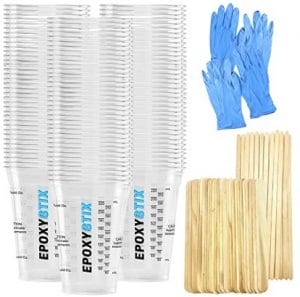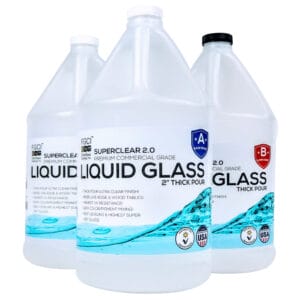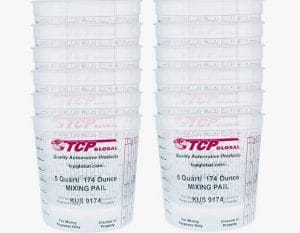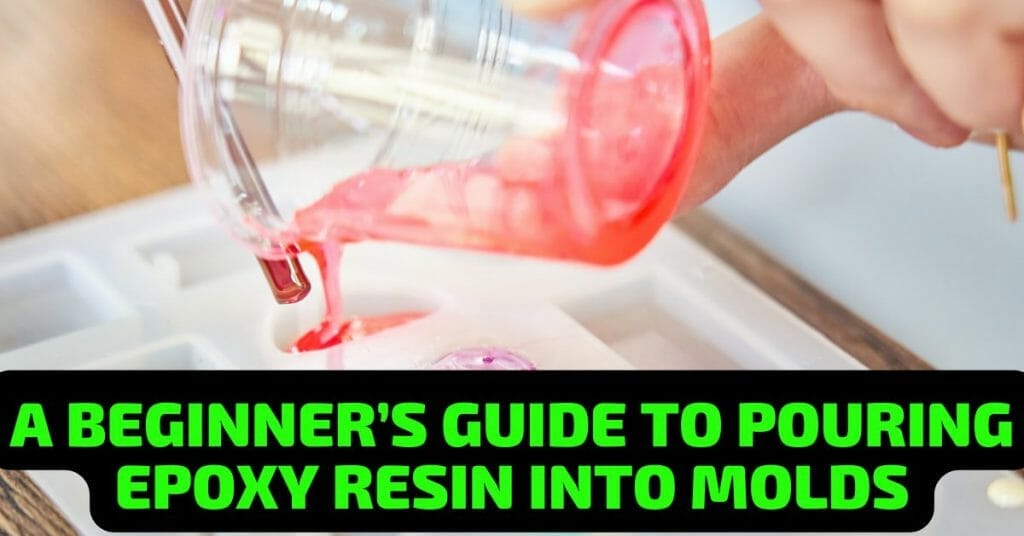How To Clean Resin Molds Properly & What Products To Consider:
Check These Out!
At Rocket Resin Molds we are dedicated to bringing you the best guide on how to clean epoxy resin molds!
How To Clean Resin Silicone Molds
To clean resin silicone molds, you can use warm water and dish soap. Be sure to rinse the molds thoroughly and allow them to dry completely before using them again.
Resin silicone molds should be cleaned before first use. This is because the mold release agent needs to be sprayed inside the mold before pouring any resin into it so that it doesn’t stick when removed from the mold.
The molds should be allowed to dry before starting your project.
A release agent is sprayed inside the mold before pouring any resin into it so that it doesn’t stick when removed from the mold (see point 3).
The molds should be thoroughly dried before being stored away (see point 4).
They are accessible to de-mold (unlike resin molds).
You can make your silicone mold with two parts silicone material, which is more accessible than making a custom resin one.
When cared for properly, silicone molds can create a very glossy product.
There are a few products that can be used to clean resin properly. These include:
- – Isopropyl alcohol
- – Acetone
- – Nail polish remover
- – Goo Gone
We recommend using either dish soap and water, isopropyl alcohol, or acetone. Make sure to avoid using any harsh chemicals or solvents like paint thinner or benzene – these can damage your silicone mold and make it difficult to use in the future.
It’s important to clean your molds regularly so that they stay in good condition. If you don’t clean them often, the resin will start to build up, and it will be more challenging to get off later on. In addition, if you don’t clean your molds regularly, they will wear out faster than if you take care of them properly.
Make sure to choose the right product depending on what type of mold. For example, dish soap and water are excellent for cleaning silicone molds, while isopropyl alcohol works well for metal ones. Be sure to read the instructions carefully before starting to know exactly what product to use and how to use it!
Soap & Water
Soap and warm water are the first steps in cleaning silicone molds. It would be best to be careful not to stretch the mold while washing it, as that could cause unwanted damage.
Never use scrubbing sponges, steel wool, or toothbrushes when cleaning your molds! Clean the mold before you put it on the material.
Spray rubbing alcohol, then allow to sit on the silicone for 15-20 minutes. Rub off with a paper towel, then wash with soap and water.
Mold Release Agent
When working with resin, you will often need to use a release agent to help get your project out of the mold. A release agent is a substance used when creating silicone molds, allowing for easier demolding. It also protects your resin molds from damage.
There are many different types of release agents available, both commercial and homemade. Standard commercial options include release agents in aerosol cans or pump bottles. You can also find powdered versions that need to be mixed with water.
Two common homemade release agents are vegetable oil and baking soda. Wax has also been a popular option for mold release agents due to its safety properties. Whichever product you choose, follow the manufacturer’s instructions for use.
How Do You Clean Resin Mixing Cups?
Resin mixing cups can be cleaned with a little soap and water. Be sure to rinse them well and allow them to air dry before using them again.
When you’re done mixing your resin, it’s essential to clean your cups properly so that there’s no residue left behind. This will help ensure that the curing process goes smoothly and that your molds are free of any contaminants.
The best way to clean your cups is by wiping them off with paper towels, alcohol, or acetone. Make sure to get all the resin off the bottom and sides of the cup, and be especially careful not to leave any on the inside or outside surfaces. If necessary, you can use a spray bottle to apply solvents and then wipe the residue off with gloves on.
Once they’re clean, wash your cups in hot, soapy water and allow them to dry before storing them away safely.
Other silicone mold care tips
In addition to cleaning your epoxy resin molds with isopropyl alcohol, you can also use a variety of other household cleaners to keep them looking new.
Just mix one part vinegar with nine parts water, pour it into a spray bottle, and spray the mold liberally. Let the solution sit for about five minutes before rinsing it off with warm water.
Just mix one tablespoon of baking soda with one cup of water, pour it into a spray bottle, and spray the mold liberally. Let the solution sit for about five minutes before rinsing it off with warm water.
Don’t mix molds and fire or heat.
While it is tempting to try and get rid of bubbles in your silicone mold by popping them, this is actually a bad idea. Silicone can withstand high temperatures of curing epoxy resin, but an open flame is another story. If you need to torch your mixed resin in a different container first and measure out the amount you need (before pouring it into the mold), be sure to follow the instructions on the label carefully. Otherwise, it will either not set or be too watery.
Be careful when demolding.
When demolding your product, be careful not to damage it. Use a gentle touch and be careful not to twist or pull the product too hard. If you have trouble getting the product out of the mold, try using a lubricant such as vegetable shortening or mineral oil.
When demolding a silicone mold, it is crucial to do so slowly and carefully to prolong its life. This can be done by removing the piece of silicone without stretching it, which can dull the surface of your mold and make it more prone to tears. The piece should not be inverted when popping out a cast from a silicone mold because this could dull the surface of your molds and make them more susceptible to tears. Demolding is easy when the silicone mold is new because the cured resin will come off. However, silicone molds are coated with a release agent during manufacturing, making demolding easy and smooth. After some use, the release agent can wear off, making demolding difficult and damaging both your creation and silicone mold in the process. Applying a mold release agent before casting can help make de-molding easier and avoid the mess that often accompanies it. The best time to apply the mold release is at least 10 minutes before casting, but applying now will prevent this issue in the future.
Don’t overpour
While it’s tempting to overpour because it can be difficult to judge how much resin is needed, this can cause damage to silicone molds. Even if they’re designed to withstand heat, overpouring can still cause problems. The best thing to do is pour in layers so that the resin doesn’t spill over the edge of the mold and create a mess.
How to Clean Molds with Tacky Resin
Molds can be cleaned with tacky resin by spraying the resin onto the mold, allowing it to dry, and then scraping off the dried resin.
When you’re dealing with tacky resin, your first instinct may be to try and scrape it all off. However, this can be difficult and time-consuming. A better option is to use a chemical cleaner like acetone to dissolve the resin. Be sure to wear gloves and follow the product instructions for safety measures.
Once you’ve removed as much of the resin as possible, you can use a baby wipe or other soft cloth to clean the mold. This method is highly effective and easy to use. It’s also a chemical, so remember to take precautions when using it.
How to Clean Resin Molds After Resin Is Cured
After your resin is cured, you will need to clean the molds to remove any excess resin. This can be done with a variety of methods, but the most common is to use a brush and some isopropyl alcohol. Be sure to clean the molds thoroughly to avoid any contamination.
After the resin is cured, it’s important to clean the molds as soon as possible. This will help avoid any damage or scratches that could occur if left uncleaned. Here are a few tips on how to clean them:
– Use a lint roller or other tool to clean the resin molds.
– Clean the flat surfaces by sticking a tool onto them and peeling them off.
– 99% isopropyl alcohol can be sprayed on the mold to help remove the dried resin.
– Never use steel wool, toothbrush, or scrubbing sponges for de-molding resin as they can scratch the surface of the mold.
– Dry resin molds with paper towels and store them in a dust-free, cool, and dry storage area.
Conclusion
Thanks for reading! We hope that this article has helped you learn more about resin molds and their benefits. Keep in mind that the key to success with this management model is patience and persistence. Let’s work together to make our organizations more productive and successful!
Will 70 isopropyl alcohol clean resin?
Many people have been asking whether 70% isopropyl alcohol can be used to clean resin. The answer is yes. It will clean most resins. However, it is not good to use this method if you are working with epoxy resin.
We recommend using a heat gun or hairdryer to scrape the resin if you don't have any other equipment.
Can isopropyl alcohol damage resin?
There are many ways to remove epoxy resin from a silicone mold, depending on the type of work being done and the equipment available. One method of removing the resin is to use a heat gun or hairdryer. Another way to remove the resin is with an X-Acto knife, paint scraper, metal spoon, or another utility blade.
Chemical strippers are useful if you don't have any other tools like a heat gun or hairdryer available to use on your flooring material.
How do you clean resin silicone molds?
Resin silicone molds can be cleaned with mild soap and water. Be sure to rinse the mold thoroughly to remove all of the soap.
There are a few things you can do to clean resin silicone molds:
-Make sure to follow the instructions on the silicone mold kit you're using, especially when it comes to curing time.
-Using two-part silicone allows for a quick and easy process of making your own molds at home or elsewhere.
-The silicone should be stirred before pouring into a mixing cup to avoid settling.
What is the best way to clean resin molds?
The best way to clean resin molds is to use a mixture of soap and water. First, wet the mold and then add a small amount of soap. Use a toothbrush to scrub the mold and then rinse with water.
There are a few different ways to clean resin molds: using release agents, vegetable oil and baking soda, or a thin layer of wax.
A release agent is used to prevent the resin from sticking to the mold. This can be sprayed on the mold before pouring in the resin, or you can dip the object into the release agent.
Vegetable oil and baking soda can also be used to clean resin molds. The oil will help dissolve any leftover resin, while the baking soda will help remove any odors. Add 1/4 cup of baking soda to 1 quart of hot water, then soak the mold for 30 minutes. Rinse with warm water and dry thoroughly.
A thin layer of wax can also be used to clean resin molds. Melt some wax and pour it over the mold until it's completely covered. Let it cool and harden, then peel off the wax.
What kind of alcohol do I need to clean resin?
You will need alcohol that is at least 70% ethanol or isopropanol.
You can use any type of alcohol to clean resin residue, but it's important to choose the right one. Acetone and isopropyl alcohol are both effective at removing resin, but they can also damage silicone surfaces. It's best to use a method that involves water or a mild soap solution to clean your molds properly.
Can you reuse epoxy mixing containers?
When you're finished using your epoxy resin, it's important to clean all of your mixing containers and cups. If you don't, the epoxy will start to stick, and it will be challenging to get it off later.
It's good to use plastic mixing vessels for your epoxy resin. That way, you won't have any sticking problems. If you use metal or glass containers, make sure to clean them thoroughly with a wet paper towel.
How do you clean silicone molds after resin?
After the resin is cured in silicone molds, the best way to clean them is to use a toothbrush and some warm, soapy water. Be sure to rinse the molds thoroughly after cleaning to remove all of the soap.
After you've finished casting your resin object in a silicone mold, it's time to clean the mold so that it can be used again. This is an important step since resin can be difficult to remove from silicone molds if not cleaned properly. Here are some tips for how to clean your silicone molds after using resin:
1. Pay attention to the curing time of the silicone so that you have a solid mold before using it with resin. If you try to cast the resin in a still-soft silicone mold, the resin may stick to the mold and be difficult to remove.
2. Make sure to follow the instructions for your silicone mold, especially when making a two-part mold for casting resin objects. Some silicones require that you release air bubbles from the two halves before casting, while others do not.
3. If your DIY silicone mold has parts that can chip away or stick to the resin, trim them away before casting. This will help prevent any damage or sticking that could occur during the curing process.
4. Stir the silicone in its original container before pouring it into a mixing cup. This will help ensure even distribution and prevent any lumps from forming in your final product.
How do you clean epoxy resin containers?
There are a few ways to clean epoxy resin containers. One way is to mix a little dish soap with warm water and use a soft cloth to clean the surface. Another is to use a mixture of vinegar and water. You can also use a commercial cleaner specifically designed for epoxy resin.
When the two parts are mixed, they form a hard, durable plastic resin. Epoxy resin can be used to make molds for casting metal or other materials.
The mold can be cleaned with soap and water, but you must take care not to damage the surface of the mold. You can also use acetone or another type of solvent to clean the mold. Be sure to read the manufacturer's instructions for cleaning epoxy resin molds before beginning.
What do you clean resin molds with?
Resin molds can be cleaned with isopropyl alcohol (IPA) or acetone. IPA can be used to clean the mold and remove any residue or contaminants. Acetone can be used to remove any cured resin from the mold.
There are a few different ways to clean resin molds, and each method depends on what you're trying to achieve. For example, if you're just trying to clean off any excess resin that may have spilled during the pouring process, then you can use soap and water. However, if you're looking for a more thorough cleaning, then you should spray rubbing alcohol onto the mold and let it sit for 15-20 minutes before using dish soap and water.
Whatever method you choose, allow the resin to dry completely before beginning work again. This will help avoid any mishaps or problems with your project.
Another thing to keep in mind is that some solvents should not be used when cleaning resin molds--such as acetone or lacquer thinner--and they definitely shouldn't be put in the dishwasher or microwave ovens. Be sure to read the manufacturer's instructions carefully before attempting any kind of cleaning!
How do you clean resin trays?
Resin trays can be cleaned with a mixture of isopropyl alcohol and water. The trays should be soaked in the mixture for a few minutes and then scrubbed with a soft brush.
You don't want to leave any leftover resin in the tray because it will harden and be difficult to remove.
Here are a few tips for cleaning your resin trays:
- Soak the tray in warm, soapy water.
- Use a toothbrush or other small brush to scrub away any leftover resin.
- Rinse the tray with warm water and dry it off.
What type of isopropyl alcohol cleans resin prints?
Isopropyl alcohol is a solvent that is effective at cleaning resin prints. It is strong alcohol that can quickly remove any residue or dirt from the surface of the print.
There are various types of isopropyl alcohol, but for cleaning resin prints, we recommend using either regular or high-grade rubbing alcohol. This alcohol dissolves the residue quickly and easily, making cleanup a breeze. In addition, it's safe to use on both plastic and metal surfaces.
Can you use 70% isopropyl alcohol on epoxy?
Yes, you can use 70% isopropyl alcohol on epoxy to remove it from a mold after applying it directly onto the surface. This method is one of several that can be used to clean epoxy resin from silicone molds.
Can you clean resin with alcohol?
It can be used to create a variety of objects, including jewelry, countertops, and figurines. One downside to working with epoxy resin is that it can be difficult to clean up once it has been cured. In some cases, you may be able to clean hardened epoxy resin with alcohol.
How do you clean resin cups and molds?
When you're done with your project, it's important to clean your resin cups and molds properly. This will help keep them in good condition so you can use them again for future projects. Here are a few tips on how to clean them:
Silicone is typically mixed with epoxy resin, slime, clay, paint, craft, molding, and casting. The silicone cups are nonstick and can be used to clean the compound before it cures or after it has cured. The silicone cups are dishwasher safe if they get dirty while you're using them during a project. You can reuse the cups if you flex them.
You can use a baking soda and water mixture to clean your old epoxy resin from silicone cups. Use a brush or your fingers to scrub off the epoxy resin. Rinse the cup with warm water and dry it off.
Can I use rubbing alcohol on epoxy resin?
When it comes to removing the residue of epoxy resin, rubbing alcohol is a popular choice. It's effective and readily available, but there are some things you should know before using it. First, rubbing alcohol can damage silicone surfaces, so it should be avoided if your project involves casting with silicone molds. Second, while rubbing alcohol is effective at removing resin residue, it also removes surface components that could have been preserved by other methods. Finally, always read the casting instructions for your particular resin to make sure you're using it correctly and getting the best results possible.






